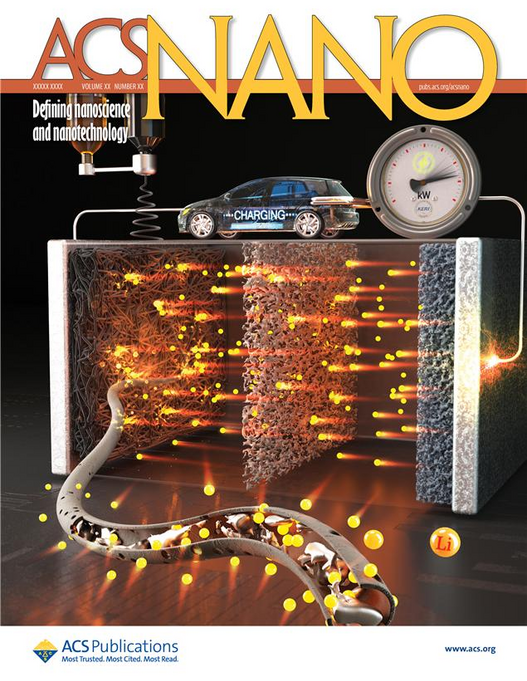The Next-Generation Battery Research Center of the Korea Electrotechnology Research Institute has conducted a study on Li-metal batteries, which was later published as a cover paper in a prestigious international journal.
 A 1D Li-confinable host with a porous carbon shell and lithiophilic Au nanoparticles in the core shows improved Li reversibility at high rates owing to the facile Li+ transport and the Li dendrite suppression by storing Li at the core place, revealing the importance of structural design for Li storage. Image Credit: Korea Electrotechnology Research Institute
A 1D Li-confinable host with a porous carbon shell and lithiophilic Au nanoparticles in the core shows improved Li reversibility at high rates owing to the facile Li+ transport and the Li dendrite suppression by storing Li at the core place, revealing the importance of structural design for Li storage. Image Credit: Korea Electrotechnology Research Institute
As opposed to the present Li-ion batteries, which require a bulky and heavy graphite anode to produce energy, a newly proposed Li-metal battery uses metallic Li as the anode instead.
With a theoretical capacity that is 10 times more than that of graphite (372 mAh/g), Li-metal (3,860 mAh/g) has progressively attracted the attention of industries that require high-capacity batteries, including electric vehicles and energy storage devices.
Despite this benefit, Li can develop into a branch-like structure known as a Li dendrite if it is not uniformly and appropriately stored during the cycling process. This causes a significant volume expansion of the electrode, which reduces the cycle life of the battery and increases the risk of safety issues like fire and explosion brought on by internal short circuits.
A modest number of gold nanoparticles with a Li affinity were introduced to the hollow core of a 1D Li-confinable porous carbon structure that KERI developed to address this problem.
Here, the gold preferentially reacts with Li, which causes Li to deposit inside the core while controlling the direction of Li’s growth. To increase the Li-ion flow toward the core space, numerous nano-sized pores are also constructed in the shell portion.
When high-rate charging was taking place, the Li deposition on the conductive carbon shell, rather than inside the core, was the main problem noticed in the existing hollow core-shell Li host.
Thus, the KERI team added many pores of nanoscale size to the shell and, despite testing at a high current density of 5 mA/cm2, significantly increased coulombic efficiency without Li dendrite development.
The simulation results revealed that the reduced Li ion diffusion length by the shell pores and enhanced Li affinity by the gold nanoparticles preserved Li deposition inside the structure even under high-current charging conditions.
Dr. Kim’s team worked with Prof. Janghyuk Moon at Chung-Ang University on this research. Additionally, the developed Li host demonstrated outstanding cycling performance over 500 cycles) while operating at a high current density of 4C rate) (retaining 82.5% of its capacity).
Furthermore, the team’s utilization of the electrospinning technique, which has advantages in mass production for material synthesis, is noteworthy for demonstrating how this technology meets reality.
The researchers stated, “Despite the merit of high capacity, the Li-metal batteries have many hurdles to be overcome for commercialization mainly due to stability and safety issues. Our study is invaluable in that we developed a technique for mass production of Li-metal reservoir with high coulombic efficiency for fast-rechargeable Li-metal batteries.”
One of the top SCIE publications in materials science published by the American Chemical Society, ACS Nano, featured this study by the KERI research team as a supplementary cover paper in its August issue. With an Impact Factor of 18.027, the journal ranks in the top 5.8% of all journals in its category.
The Technology Development Program to Solve Climate Changes of the National Research Foundation and the KERI Primary Research Program provided funding for this study.
The team intends to keep working toward commercializing Li-metal batteries by, for instance, creating functional electrolytes that would guarantee the steady deposition and dissolution of metallic Li.
Journal Reference
Kang, D. W., et al. (2022) One-Dimensional Porous Li-Confinable Hosts for High-Rate and Stable Li-Metal Batteries. ACS Nano. doi:10.1021/acsnano.2c01309.